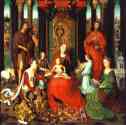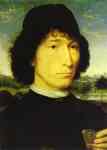Hans Memling Biography
Hans Memling (Memlinc or Hemling) – Flemish artist of German origin, active in the Netherlands in the second half of the XV century. Hans Memling was born around 1430-1440 in Seligenstadt in the Main region. Little is known about his training and early work. Perhaps he was trained in Cologne. Already in 1465, he was mentioned in Brussels, and from 1466 he worked in Bruges. Many art historians agree that he was most probably a late pupil of
Rogier van der Weyden; in any case, the latter’s influence is noticeable in Memling’s earliest authenticated works, although in some works he surpassed his probable teacher. This is true, for example, for the Triptych from Prado, which stands out for its horizontal structure. The Triptych adorned Charles V’s oratory at the royal residence in Aceca; two of the Magi are usually identified as Charles the Bold and Phillip the Good.
Early Memling also experienced the influence of Bouts. However, he soon developed his own style, which is characterized by the great charm of the figures in movement and expression, beautiful colors and narrative richness.
In 1467, Memling was accepted as a master in St. Luke League of painters. From 1468 till 1486, he was the artist number one in Bruges and the most popular Flemish artist abroad. He enjoyed multiple commissions for altarpieces from practically all over Europe. Although Florentine art and Venetian art were reaching the peak of their perfection, Memling’s works were highly prized in Italy for their calm harmony and solidity. He ultimately lacks the powers of invention and observation of Hugo van der Goes, even though he adopted many innovations of the latter. The Mystic Marriage of St. Catherine, the central panel of St. John Altar, brings together many of the typical characteristics of Memling’s art. It became a norm to use realistic forms from everyday life for religious subjects: the angels have no more need for wings and the saints for nimbuses. All the saints are identified by their attributes: St. Catherine by her wheel, St. Barbara by her tower, St. John the Baptist by a cross and a sheep, St. John Evangelist by his chalice.
Memling’s late work shows elements of the Early Italian Renaissance. Besides religious works he executed portraits of his contemporaries, more than 25 portraits belonging to him are known, among them such works as Portrait of an Italian with a Roman Coin, Portrait of a Praying Man. (1480-1485).
After having long been regarded as the greatest painter of the late XV century, Memling is now less admired, but still he deserves attention.
Bibliography
Memling. by M. German. Leningrad. 1983.
Painting of Europe. XIII-XX centuries. Encyclopedic Dictionary. Moscow. Iskusstvo. 1999.
Bruges and the Renaissance: Memling to Pourbus by Maximiliaan P. J. Martens (Editor), Wim Blockmans (Contributor), Maryan Wynn Ainsworth (Contributor). Harry N Abrams, 1999.
Memling's Portraits by Till-Holger Borchert. Thames & Hudson, 2005.
Flemish Primitives II: Bouts, Christus, Memling, Goes by C. Stroo. Brepols Publishers, 1999.
Hans Memling: the Complete Works by Dirk De Vos. Thames and Hudson, 1994.
- Triptych: The Nativity, The Adoration Of The Magi, The Presentation In...

c.1470s. Oil on panel. Museo del Prado, Madrid, Spain. Read Note.
- The Mystic Marriage Of St. Catherine. (Central Panel Of The St. John...

1474-1479. Oil on wood. Memlingmuseum, Stedelijke Musea, Bruges, Belgium. Read Note.
- Portrait Of An Italian With A Roman Coin (Giovannide Candida).

1470. Oil on panel. Royal Museum of Fine Arts, Antwerp, Belgium.